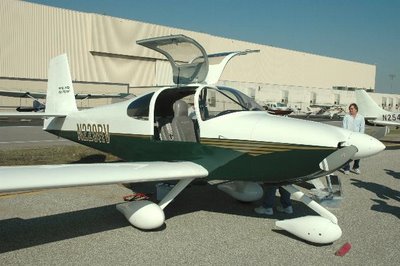The idea for the doubler comes from the compendium of 24 years worth of newsletters from the Van's factory. This problem has been well known since the mid-90's, and in fact caused a change in the design of the trim tab. For me, though, the suggested fix is adequate: stop drill the crack, remove the control horn, fabricate a doubler from .032" or .040" 2024-T3 sheet metal, and rivet it all back together. I'm not thrilled with the look of the stop drill hole, but this plane has always been intended to be a weekend flyer, not a show plane. I'll stop seeing it within a week or two anyway once I get used to it being there.
I'm nearly done with my sheet metal class, and I think I'm going to miss it. There's something almost therapeutic about the work, and the feeling of accomplishment arising from creating a piece of airplane starting with a drawing and a flat piece of metal is going to be hard to substitute. This has gotten me to thinking about building again.
I had previously considered building an RV-8, but the more I think about it, that doesn't go far enough ahead of where I am today with my -6. All it would accomplish, other than the immense satisfaction of creating my very own airplane, would be a change in seating arrangements. I don't mean to discount the value of the building process, obviously, but co-goals in all of this MUST be to make a sound financial decision and to advance the capabilities of my airplane.
Thge sound financial decision aspect excludes building anything that doesn't have a vibrant and sustained resale value, and the run-away leader in that realm is clearly the Van's planes. Even today, with over 4,000 of them flying, it is possible to build for $80k and sell for $100k. I can't think of any other homebuilt that has that benefit. The combination of the immense and supportive user community and the reasonable insurance rates that result from the well-known safety history of the fleet combine to make a unique offering within the homebuilt community. The financial stability of the factory is important too.
I think about this a lot. A whole lot. I've narrowed it down to a couple of possible approaches, each having its own set of pros and cons. Approach 1 would be to find a 50% partner in building/owning the 4-seat RV-10, selling the RV-6 when the -10 is just about done, and buying my own single-seat "play" plane to address the non-travel, throw it around the sky kind of flying. Single-seat planes are very cheap because nearly everyone wants to carry at least one passenger now and then. The options run from a single-seat biplane such as an EAA biplane, up to an RV-3.
Here's an RV-10:

Not as sexy as the taildragging RVs, but great performance for 1/4 the cost of a similar store-bought plane.
Approach 2 goes the whole-hog into having a 2-seat airplane and no partner. In this case I would be building my dream plane: an F1 Rocket.

The Rocket is simlar in size to the RV-8, but uses a much larger engine, usually at least 260hp, compared to the 160-180 hp of the RV-8. Fun, fun, FUN to fly! It's a quick-build kit, which offers the benefit of faster completion but increases initial cost significantly. Still, one can be built for just under $100k, but easily sold at at least a 20% profit should I ever decide I'm not interested in having fun anymore. I have to say, though, that it's hard to see me ever getting tired of 190 knots and 3000fpm climb!
If neither of those works out, there's always this:

Well, probably not that.

No comments:
Post a Comment